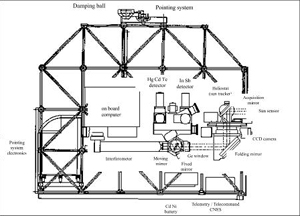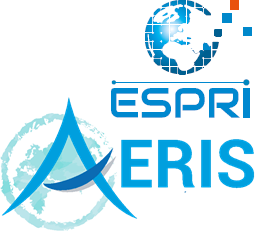
ESPRI est un centre de données du Pôle National Atmosphère AERIS

Accueil StraPolEté
......................................
Groupes de travail
......................................
Partenaires
......................................
Instruments
......................................
Campagne
......................................
Accès aux données
......................................
Galerie photo
......................................
Bibliographie
......................................
Contacts et liens
.................................
StraPolEte : Instruments (only in english)
Spirale
|
The SPIRALE (SPectroscopie Infra-Rouge par Absorption de Lasers Embarqués) balloon–borne instrument performs in situ simultaneous measurements of a number of long–lived and short–lived chemical species among O3‚ CH4‚ CO‚ CO2‚ N2O‚ HNO3‚ NO2‚ NO‚ HCl‚ HOCl‚ H2O2‚ OCS‚ COF2 from 10 km up to 40 km height. It uses six tunable salt laser diodes in the mid–infrared domain (3 to 10 µm). The laser beams are injected into an air–open multipass Heriott cell comprised between two mirrors of 35 cm diameter and located under the gondola. The cell (3.5 m) is deployed during the flight ascent above 300 hPa. In general 123 reflections occur‚ giving a 431 m optical path. Species concentrations are retrieved from direct absorption‚ by fitting experimental spectra with spectra calculated using HITRAN 2004 database and further updates. The instrument provides measurements with a vertical resolution of a few meters‚ a high sensitivity (mixing ratio > 20 pptv) and a high precision (3 to 20%). SPIRALE flew successfully from the balloon launching bases in Kiruna (Sweden‚ 67.5ºN)‚ Aire sur l'Adour (France‚ 43.4–N)‚ Gap (France‚ 44.3ºN) and Teresina (Brazil‚ 5.1ºS). SPIRALE is used routinely as part of French national (e.g.‚ StrapolÉté)‚ European (SCOUT–O3)‚ and satellite validation (Envisat) campaigns. Contact : V. Catoire |
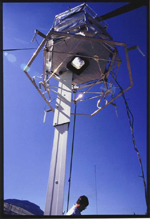 |
SALOMON–N2
|
The new SALOMON–N2 (french acronym for Spectroscopie d'Absorption Lunaire pour l'Observation des Minoritaires et NOx – Nacelle 2) balloon–borne instrument funded by CNES and developed at LPC2E is derived from the concept of its predecessor‚ SALOMON. Flights are operated by CNES in the frame of international campaigns conducted at various latitudes (from the Kiruna‚ Aire sur l'Adour‚ and Teresina launching bases) and seasons between the tropopause and altitudes around 40 km. The first flight occurred successfully on June 2007 at mid–latitudes. Using UV–visible spectrometry (continuously between 350 and 970 nm) and the moon as light source‚ SALOMON-N2 provides the concentration vertical profiles of various stratospheric chemical species (ozone‚ NO2‚ NO3 and OClO) and the spectral dependence of aerosol extinction as a function of altitude. To successfully perform this type of remote observations‚ an ensemble of mechanisms (using complementary techniques in optics‚ automatics‚ mechanics and electronics) allowing control of the gondola motion and moon light capture despite the balloon movements has been developed at LPC2E. SALOMON-N2 has been adapted to sun pointing in the frame of the StraPolEté project for the observations of bromine monoxide BrO. Contact : G. Berthet |
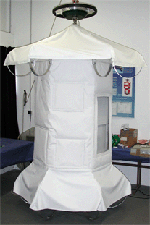 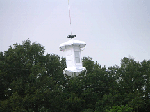 |
STAC
|
The STAC (Stratospheric and Tropospheric Aerosols Counter) particle counter‚ in operation since 1995‚ is an in situ instrument dedicated to the measurement of the aerosol size distributions from the middle troposphere to the middle stratosphere. Initially developed by the LMD‚ STAC has been managed under the technical and scientific responsibility of the LPC2E since 2005. STAC provides concentration profiles of liquid particles for diameters greater than 0.35 micrometer‚ and of solid particles for diameters greater than 1 micrometer. It is commonly implemented on board various gondolas‚ in particular ELHYSA‚ SPIRALE and SALOMON-N2. The balloons carrying STAC are launched from Aire ur l'Adour‚ kiruna and Teresina. Contact : J.–B. Renard |
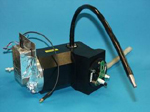 |
SWIR–balloon
|
SWIR–Balloon is a new configuration of IASI–Balloon experiment for with the detectors and filters will be modified to cover short wave infrared spectral regions in order to perform improved nadir soundings measurements of CO‚ CO2‚ and CH4. The IASI balloon instrument is derived itself from the Limb Profile Monitor of the Atmosphere (LPMA) instrument‚ based on a Bomem DA2 design which has been flown many times as a solar occultation FTIR for the determination of the vertical profiles of stratospheric species like HCl and ClONO2‚ CF2Cl2‚ NO2‚ HNO3‚ and for radiative transfer studies of major atmospheric absorbers like CO2‚ CH4 and O2. We have been able to convert the instrument from this solar absorption configuration into a nadir looking thermal emission configuration by replacing the suntracker with a one rotation axis acquisition mirror and a set of warm and cold calibration blackbodies for precise radiometric calibration. The liquid nitrogen cooled HgCdTe and InSb detectors used at high flux level in the solar configuration have been replaced by more sensitive detectors (1 mm x 1 mm instead of 0.25 mm x 0.25 mm, higher D*) of the same type to cover the thermal and mid–infrared region from 600 to 3000 cm-1 (16.7 µm to 3.3 µm). The scene sampled by the instantaneous field of view (IFOV) of the instrument is analysed with a CCD visible camera (then operating during the day only) with provision for an infrared camera (IR CCD) in the near future for night operation. The instrument is accommodated in a stratospheric gondola with azimuth control as shown in the figure. This gondola is operated in the field by the "Département Nacelle" of the balloon division (BA/NA) based at CNES in Toulouse‚ France. Contact : S. Payan |

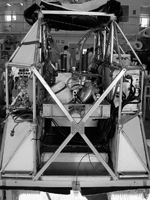
|
|
The balloon–borne experiment LPMA has been used in the framework of several European projects supported by DG XII during several major international field campaigns (SESAME, THESEO) as well as for the balloon validation campaign of the ILAS instrument‚ a solar occultation infrared absorption spectrometer onboard the Japanese ADEOS platform. The LPMA instrument is a balloon–borne Fourier transform infrared (FTIR) spectrometer operating in absorption against the sun– which allows to acquire atmospheric spectra with high signal to noise ratio. The spectrometer is accommodated on a stratospheric gondola with azimuth control (on a design of Geneva Observatory)‚ which is maintained and operated by the balloon division BA/NA ("Nacelles pointées") of Centre National d'Etudes Spatiales (CNES) in Toulouse‚ France. The FTIR interferometer (of the Bomem DA2 type) can be operated at a maximal optical path difference (OPD) of 50 cm producing an apodised spectral resolution of 1/OPD = 0.020 cm-1. This high spectral resolution is increasing the sensitivity of the instrument to low abundance stratospheric species like HCl and ClONO2‚ NO2‚ CF2Cl2 and HNO3. The instrument has also been used for testing radiative transfer models and databases for CO2‚ CH4 and O2. The schematics of the gondola with its associated FTIR instrument can be seen in the figure. |
|
The azimuth control system is activated during flight based on the horizontal direction of the local Earth magnetic field to put the sun within the field of view of the suntracker providing then fine pointing in the direction of the photometric centre of the sun. There is enough space into the gondola (mass < 450 kg) to accommodate a "piggy-back" instrument which can be either DOAS or CAESR depending on the scientific objectives of the given balloon flight. In the first case‚ the instrument DOAS (Differential Optical Absorption Spectroscopy) combining a UV and a visible spectrometer is sharing (through optical fibres) with the LPMA interferometer the solar beam at the output of the suntracker. In this manner both instruments are looking exactly at the same line of sight. In the second case‚ the instrument CAESR (Cold Atmospheric Emission Spectral Radiometer) of Denver University is operating during balloon ascent in thermal emission at a fixed elevation angle in the direction opposite to the sun. Coming back to the LPMA instrument‚ several additional characteristics have to be underlined. First because wide spectral intervals of the infrared or near infrared can be covered through the use of a dual detector output optics‚ a suite of atmospheric species can be measured simultaneously. Second‚ through the combination of coarse azimuth control and fine sun tracking with the heliostat‚ measurements are performed both during ascent and during solar occultation (at sunset) producing two vertical profiles during the same balloon flight for each species having spectral signatures in the domains covered. Finally‚ by an appropriate choice of beamsplitter ‚ dichroic‚ filters and detectors‚ the optical configuration of LPMA can be tailored to meet different scientific objectives and target species depending on the satellite instrument for which correlative balloon–borne measurements are requested. Contact : S. Payan |
MicroRADIBAL
|
The microRADIBAL instrument is a radiometer that can be flown on a stratospheric platform to study the aerosols. It measures the radiance and polarization of the sunlight scattered by the atmosphere‚ gas and aerosols‚ in a horizontal plane during the ascent and/or descent of the balloon. The measurements are performed in the near infra–red range, with five channels centred at 730‚ 865‚ 1000‚ 1270 and 1620 nm‚ the three first channels being equipped with silicium detectors while the two others are InGaAs detectors cooled by a one stage Peltier module. The instrument is composed of 15 separate optics whose axes are parallel‚ with narrow fields of view (FOV=1.5°). They are arranged in groups of 3 for each wavelength‚ the 3 optics being equipped with analyzers positioned 60° one from each other in order to derive the polarized light. The radiometer detects the scattered sunlight and an absolute calibration in the laboratory enables radiance and degree of polarization of the light to be inferred. The rotation of the gondola around the vertical axis allows the observation of the stratosphere under various scattering angles. Measured diagrams versus scattering angle enable‚ via modelling‚ the characterization of the stratospheric aerosols. They are characterized by their spectral extinction coefficients‚ size distribution and number density as function of the altitude (~12 – 28 km). Information on their phase and refractive index is also retrieved. MicroRADIBAL is completed by an instrument (REVORAD) measuring the underlying atmosphere reflectance. Contact : C. Brogniez |
DOAS
|
A DOAS instrument optimized for airborne applications was designed and described‚ for example‚ by Ferlemann (1998)‚ Harder (1999) and Ferlemann (2000). The basic features of the instrument are low weight‚ low power consumption‚ stable spectral imaging and insignificant thermal drift of the spectroscopic system. The instrument consists of two spectrographs in one housing‚ which analyse the UV and the visible part of the sunlight separately (see Figure). The light enters each of the two spectrographs via a quartz fibre bundle‚ which forms a rectangular entrance slit at the fibre end on the spectrograph side. Telescope optics are mounted on the other end of the fibre bundles‚ intended to average the light received from the sun‚ to limit the spectral transmission range of the incoming light and to match the f-number of each spectrometer. Coming from the entrance slit‚ the light reaches a holographic grating‚ which disperses the light of the respective wavelength range in 1st-order onto the detector (UV: 316.5-417.3 nm and visible: 399.9-653.0 nm. The light is detected with Peltier cooled photodiode arrays. The width of the entrance slit was chosen to fulfill the sampling criteria given by Roscoe (1996)‚ i.e. the FWHM of the instrument function should be sampled with more than 4.5 detector pixels. The instrumental resolution is found to be 0.55 nm (= 5.5 detector pixels) and 1.48 nm (= 5.7 detector pixels) for the UV and the visible spectrometer‚ respectively. The whole spectrometer housing is evacuated and thermally stabilized by a surrounding vessel filled with a water-ice mixture. Keeping the spectrograph at a stable temperature of 0ºC avoids spectral shifts. In addition‚ a refrigerant circulates in a cooling circuit to regulate the temperature of the optical components and to cool the warm side of the photodiode Peltier elements. Low spectrometer stray light is achieved by suppressing the higher-order and zero-order grating reflections by using light traps. In the wavelength range covered by the combination of the UV and vis spectrograph‚ absorption features of several species can be found‚ e.g. O3‚ BrO‚ NO2‚ OClO‚ HONO‚ HCHO‚ O4 etc. in the UV range and O3‚ NO2‚ H2O‚ O4‚ NO3‚ OClO‚ IO‚ OIO etc. in the visible range. Contact : M. Dorf |
